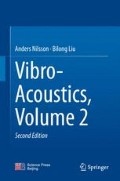Abstract
In general, the noise level inside a building or structure is determined by the transmission of air-borne sound from external and internal acoustic sources and by structure-borne sound induced by some mechanical sources.
Access this chapter
Tax calculation will be finalised at checkout
Purchases are for personal use only
Author information
Authors and Affiliations
Corresponding author
Problems
Problems
13.1
Calculate the radiation ratio \(\bar{\sigma }_\mathrm{a}\) for an infinite plate, \(\mu = 22\) kg/m\(^{2}\) and \(f_\mathrm{c}=720\) Hz, in the frequency range up to 500 Hz.
13.2
Determine how the sound transmission loss for a single leaf panel is changed if the thickness of the homogeneous plate is changed from \(h_1 \) to \(h_2 \). Consider the frequency intervals \(f\ll f_\mathrm{c}\) and \(f > f_\mathrm{c}\).
13.3
Show that
For notations, see Sect. 13.3.
13.4
A stiff plate is mounted as shown in Fig. 13.22. Determine the mobility of the plate as function of the distance d between plate and bottom structure. The mass per unit area of the infinitely stiff plate is \(\mu \) and its area S. The fluid in the cavity is air.
13.5
Show that
can close to a maximum be expanded as
13.6
Solve
Make the integration along a semi-circle in the upper half plane of the complex plane.
13.7
Show that the sound transmission loss is independent of boundary conditions for \(f > f_\mathrm{c}\).
13.8
Follow the one-dimensional procedure for the clamped plate to indicate the solution for a simply supported plate.
13.9
Determine the sound transmission loss of a double construction consisting of two panels with a cavity between them. Assume that the acoustic field between the plates is diffuse.
13.10
Determine the double wall resonance frequency given in Eq. (13.130).
13.11
Determine the sound transmission loss of a structure with a water load on one side. Consider only normal incidence.
13.12
Show that the sound transmission loss for a panel between two rooms tends to the sound transmission loss of an infinite panel as the dimensions of the rooms becomes infinite.
Rights and permissions
Copyright information
© 2016 Science Press, Beijing and Springer-Verlag Berlin Heidelberg
About this chapter
Cite this chapter
Nilsson, A., Liu, B. (2016). Sound Transmission Loss of Panels. In: Vibro-Acoustics, Volume 2. Springer, Berlin, Heidelberg. https://doi.org/10.1007/978-3-662-47934-6_13
Download citation
DOI: https://doi.org/10.1007/978-3-662-47934-6_13
Published:
Publisher Name: Springer, Berlin, Heidelberg
Print ISBN: 978-3-662-47933-9
Online ISBN: 978-3-662-47934-6
eBook Packages: Physics and AstronomyPhysics and Astronomy (R0)


